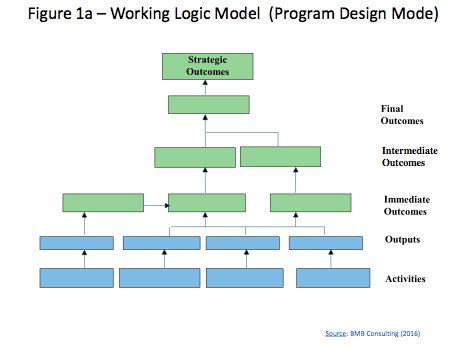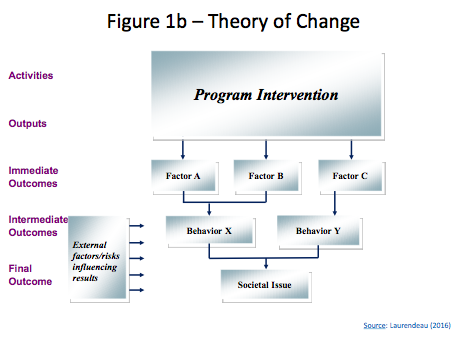AEA365 Curator note: Today begins a special theme week with an extended (7 day) series on one topic by one contributing author.
Hello, my name is Michel Laurendeau, and I am a consultant wishing to share over 40 years of experience in policy development, performance measurement and evaluation of public programs. This is the first of seven (7) consecutive AEA365 posts discussing a stepwise approach to integrating performance measurement and evaluation strategies in order to more effectively support results-based management (RBM). In all post discussions, ‘program’ is meant to comprise government policies and broader initiatives involving multiple organizations.
Step 1 of 7 – Developing the Theory of Change (TOC)
Effectively addressing an issue normally requires first understanding what you are dealing with. Models are generally used in evaluation to help clarify how program are meant to work and achieve intended results. However, much confusion exists between alternative approaches to modelling, each based on different ways of representing programs and the multiple underlying assumptions on which their interventions are based.
Top-down models, such as the one presented in Figure 1a, usually provide a narrow management perspective relying on inductive logic in order to select the evidence (based on existing knowledge and/or beliefs) that is necessary to support ex ante the strategic and operational planning of program interventions. Assumptions are then entirely about whether the program created necessary and/or sufficient conditions (as discussed in the TOC literature) for achieving intended results. In this context, the role of ex post evaluation is too often limited to focusing on program delivery and vindicating management’s contention that observed results depend to some (usually unknown) extent on existing program interventions.
As a research function, evaluation should also support (re)allocation decisions being made by senior government officials regarding the actual funding of public programs. However, this stronger evaluation role would involve reliably assessing individual program contributions to observed results in a given context, and require properly measuring real/actual program impacts while taking external factors into account.
The first difficulty in achieving this task is recognizing that Randomized Control Trials (RCT) are rarely able to completely eliminate the influence of all external factors, and that the statistical ‘black box’ approach it uses prevents reliably transposing (i.e., forecasting by extrapolating) observed results to situations with varying circumstances. Generalization is then limited to a narrow set of conditions formulated as broad assumptions about the context in which the program operates. Providing a more extensive base to reliably measure program effectiveness would entail, in a first step:
- developing more exhaustive Theories of Change (TOC) including all factors that created the need for program interventions and/or that likely have an influence on the issue or situation being addressed by the program; and,
- determining which factors/risks within the TOC are meant to be explicitly ‘managed’ by the program, with all others becoming external to the program intervention.
Figure 1b shows what a program logic model would normally look like at the end of this first step.
The next AEA365 post will articulate the approach to the development of the more detailed Program Theory of Intervention (PTI) that is imbedded within the broader TOC.
Do you have questions, concerns, kudos, or content to extend this aea365 contribution? Please add them in the comments section for this post on the aea365 webpage so that we may enrich our community of practice. Would you like to submit an aea365 Tip? Please send a note of interest to aea365@eval.org . aea365 is sponsored by the American Evaluation Association and provides a Tip-a-Day by and for evaluators.



Really interesting, thanks